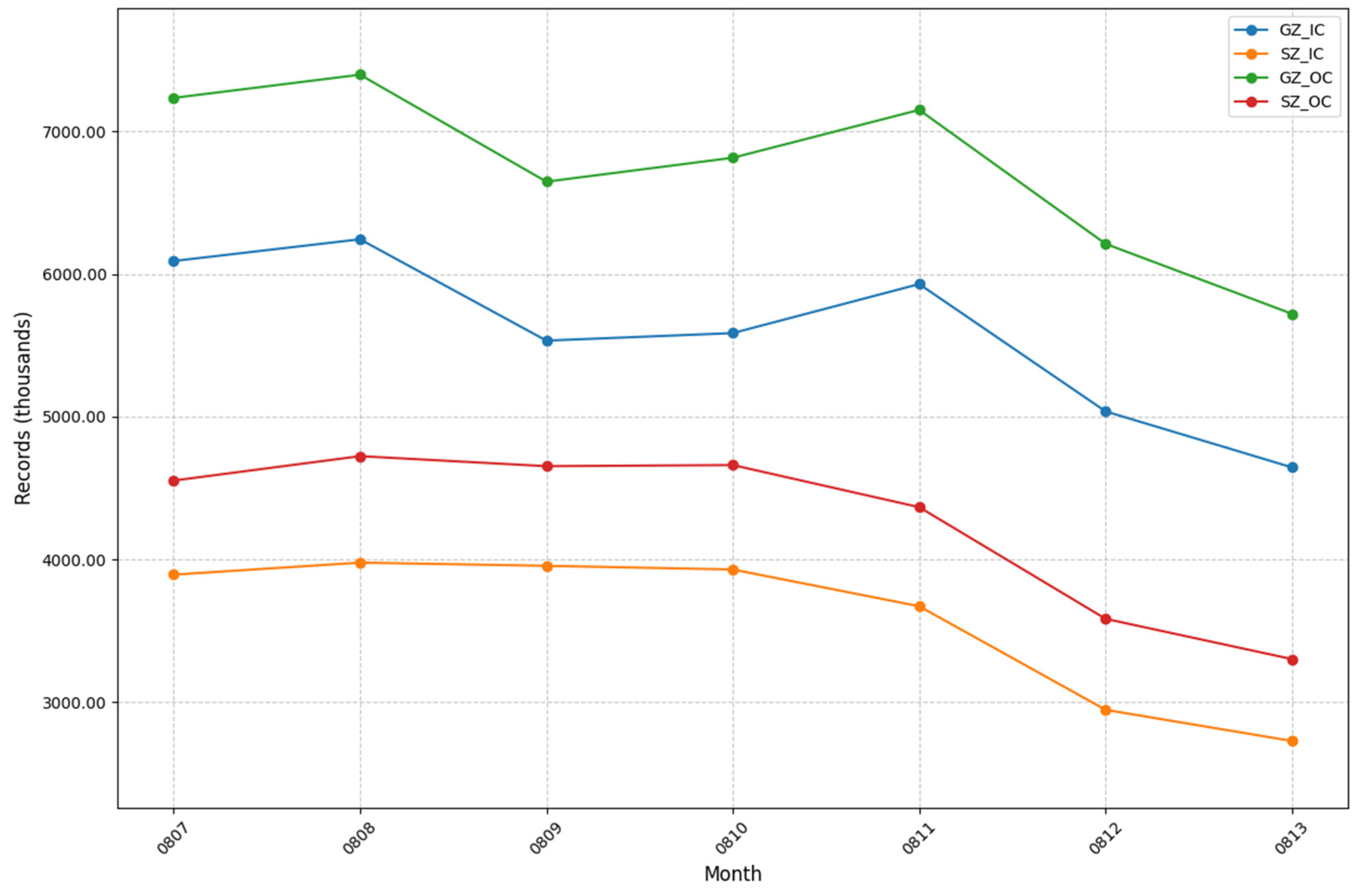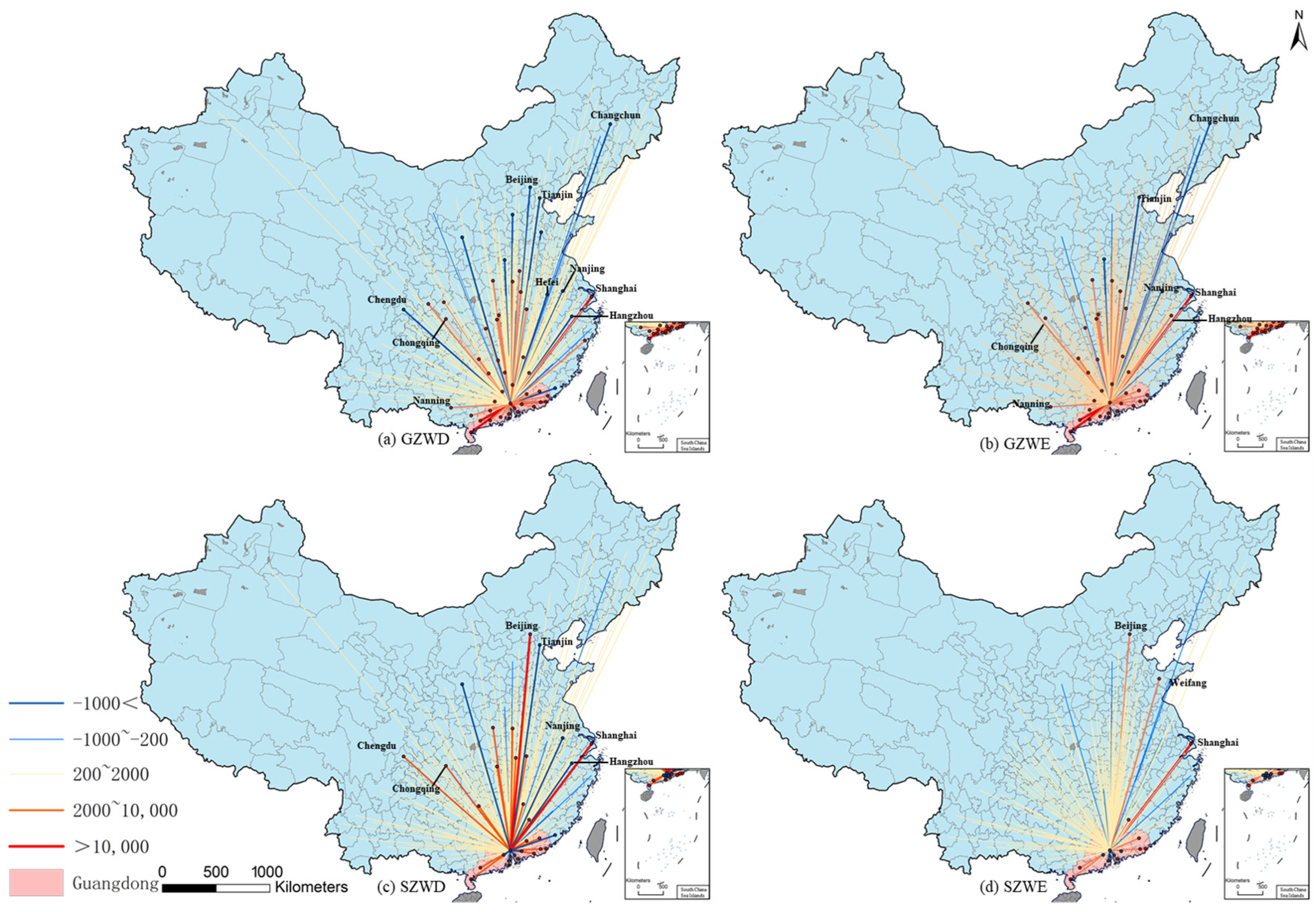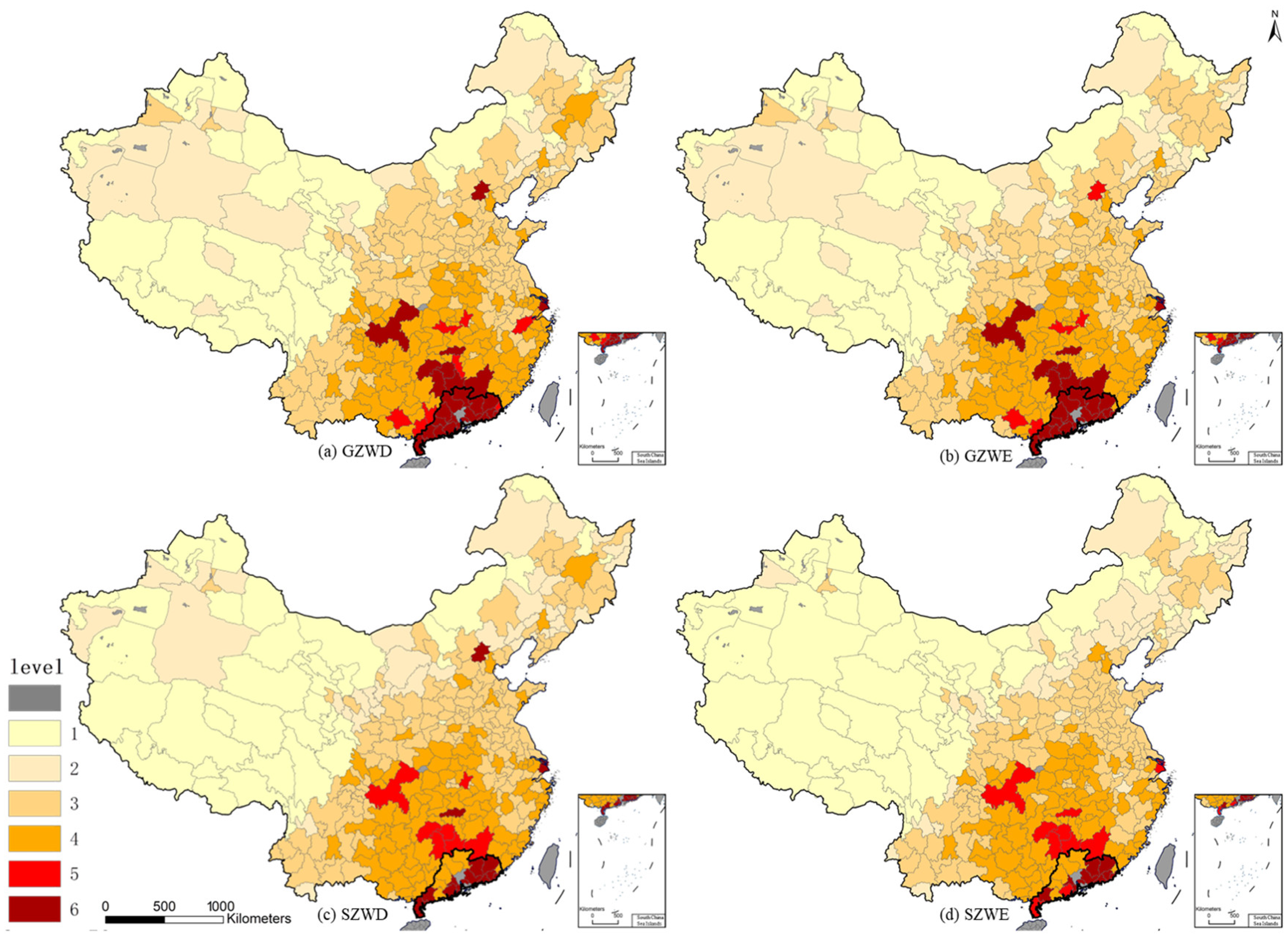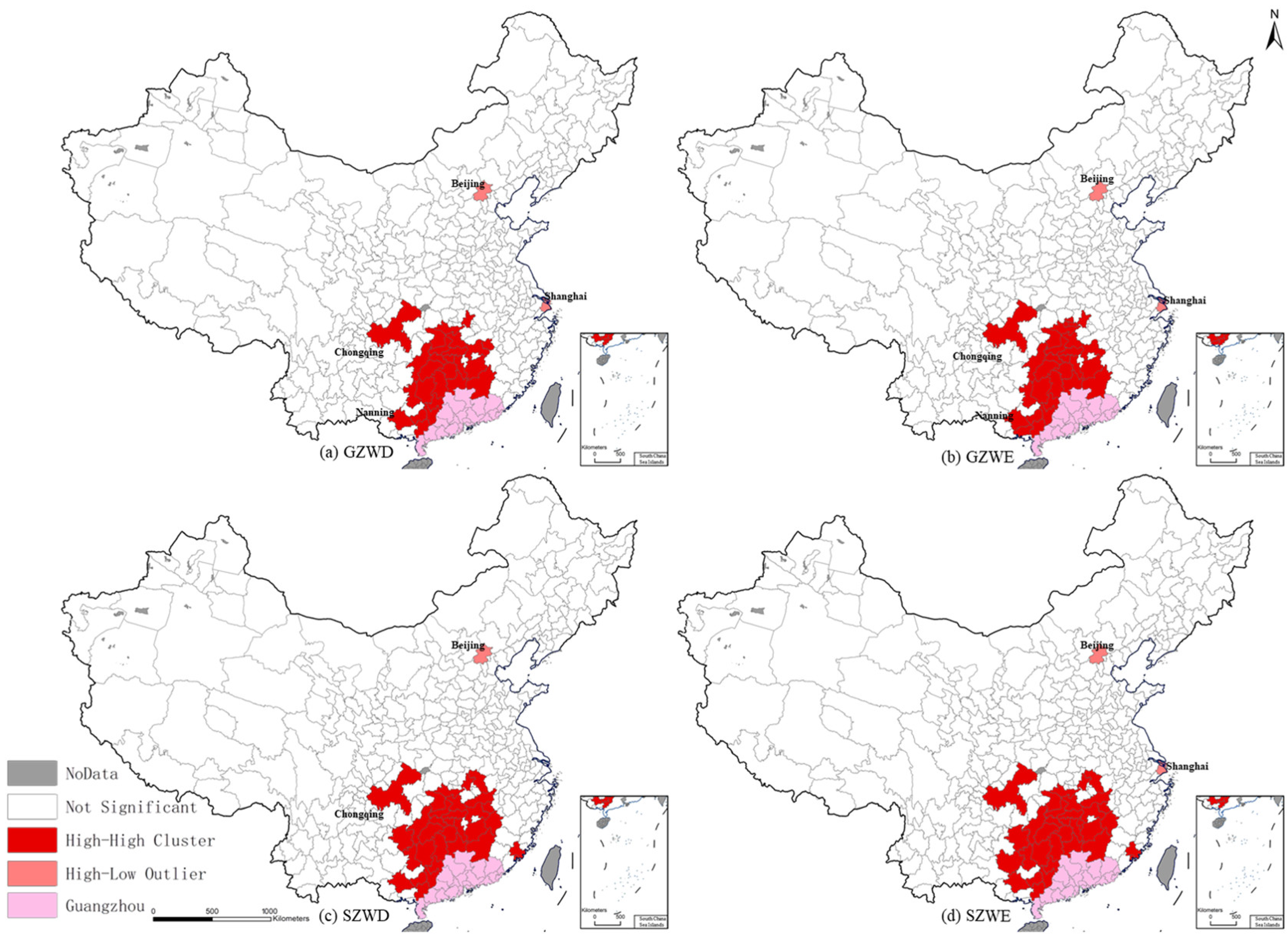Quantifying Virtual Urban Commercial Linkages Using Spatial Phone Call Data—A Comparative Study Between Guangzhou and Shenzhen
Abstract
1. Introduction
2. Study Area
3. Materials and Methods
3.1. Call Detail Records
3.2. Method
3.2.1. Modified Gravity Model
3.2.2. Geodector Method
3.2.3. Local Moran’s I
4. Results
4.1. Quantitative Analysis of Call Records
4.2. Flow Characteristics of Call Records
4.3. Urban Linkage Characteristics
4.4. Potential Driving Force Detecting
5. Discussion
6. Conclusions
Author Contributions
Funding
Data Availability Statement
Acknowledgments
Conflicts of Interest
Abbreviations
| CDRs | Call detail records |
| IC | Incoming calls |
| OC | Outcoming calls |
| GZWD | Guangzhou weekdays |
| GZWE | Guangzhou weekend |
| SZWD | Shenzhen weekdays |
| SZWE | Shenzhen weekend |
| CDRF | Call data record flow |
References
- Wang, Q.; Zhao, M. Research on the city network of Guangdong, Hongkong and Macao from the perspective of information flow: Analysis based on baidu index. J. Reg. City Plan. 2018, 29, 281–293. [Google Scholar] [CrossRef]
- Zhang, H.M.; Sun, T.S. Disentangling urban network externalities: The juxtaposition of central place theory and central flow theory. Reg. Stud. 2025, 59, 2461753. [Google Scholar] [CrossRef]
- Castells, M. Rise of the Network Society: The Information Age: Economy, Society and Culture; Wiley: Hoboken, NJ, USA, 1996. [Google Scholar]
- Alavi, S.A.; Esfandi, S.; Khavarian-Garmsir, A.R.; Tayebi, S.; Shamsipour, A.; Sharifi, A. Assessing the Connectivity of Urban Green Spaces for Enhanced Environmental Justice and Ecosystem Service Flow: A Study of Tehran Using Graph Theory and Least-Cost Analysis. Urban Sci. 2024, 8, 14. [Google Scholar] [CrossRef]
- Batten, D.F. Network cities: Creative urban agglomerations for the 21st century. Urban Stud. 1995, 32, 313–327. [Google Scholar] [CrossRef]
- Zhen, F.; Qin, X.; Ye, X.; Sun, H.; Luosang, Z. Analyzing urban development patterns based on the flow analysis method. Cities 2019, 86, 178–197. [Google Scholar] [CrossRef]
- Lüthi, S.; Thierstein, A.; Hoyler, M. The world city network: Evaluating top-down versus bottom-up approaches. Cities 2018, 72, 287–294. [Google Scholar] [CrossRef]
- Sainan, L.; Huilin, D.; Xinyu, P.; Shudi, C.; Yu, W. Pattern and Influencing Factors of Urban Spatial Connection in Wuhan Metropolitan Area from the Perspective of Flow Space. Econ. Geogr. 2024, 44, 81–89. [Google Scholar]
- Freeman, L.C. Centrality in social networks conceptual clarification. Soc. Netw. 1978, 1, 215–239. [Google Scholar] [CrossRef]
- Beaverstock, J.V.; Smith, R.G.; Taylor, P.J.; Walker, D.R.; Lorimer, H. Globalization and world cities: Some measurement methodologies. Appl. Geogr. 2000, 20, 43–63. [Google Scholar] [CrossRef]
- Beaverstock, J.V.; Smith, R.G.; Taylor, P.J. World-city network: A new metageography? Ann. Assoc. Am. Geogr. 2000, 90, 123–134. [Google Scholar] [CrossRef]
- Christaller, W. Central Places in Southern Germany; Prentice-Hall: Englewood Cliffs, NJ, USA, 1966. [Google Scholar]
- TAYLOR, P. Urban hinterworlds: Geographies of corporate service provision under conditions of contemporary globalisation. Geography 2001, 86, 51–60. [Google Scholar] [CrossRef]
- Castells, M. Globalisation, Networking, Urbanisation: Reflections on the Spatial Dynamics of the Information Age. Urban Stud. 2010, 47, 2737–2745. [Google Scholar] [CrossRef]
- Henderson, J.; Dicken, P.; Hess, M.; Coe, N.; Yeung, H.W.C. Global production networks and the analysis of economic development. Rev. Int. Political Econ. 2002, 9, 436–464. [Google Scholar] [CrossRef]
- Pan, J.; Lai, J. Spatial pattern of population mobility among cities in China: Case study of the National Day plus Mid-Autumn Festival based on Tencent migration data. Cities 2019, 94, 55–69. [Google Scholar] [CrossRef]
- Wang, X.; Pei, T.; Song, C.; Chen, J.; Shu, H.; Chen, X.; Wu, M. A new flow-based centrality method for identifying statistically significant centers. Sustain. Cities Soc. 2023, 99, 104984. [Google Scholar] [CrossRef]
- Ghanbari, M.; Karimi, M.; Claramunt, C.; Lagesse, C. Enhancing Urban Transportation Flow Modeling Through a Graph Neural Network-based Spatially Weighted Interaction Model: A Case Study of Chicago Taxi Data. J. Geovisualiz. Spat. Anal. 2025, 9, 15. [Google Scholar] [CrossRef]
- Li, C.; Lin, S.; Wang, Y.; Chen, L. Evaluation of regional integration in urban agglomeration area from the perspective of urban symbiosis. Sustain. Cities Soc. 2024, 105, 105338. [Google Scholar] [CrossRef]
- Chong, Z.; Pan, S. Understanding the structure and determinants of city network through intra-firm service relationships: The case of Guangdong-Hong Kong-Macao Greater Bay Area. Cities 2020, 103, 102738. [Google Scholar] [CrossRef]
- Taylor, P.J.; Derudder, B.; Faulconbridge, J.; Hoyler, M.; Ni, P.F. Advanced Producer Service Firms as Strategic Networks, Global Cities as Strategic Places. Econ. Geogr. 2014, 90, 267–291. [Google Scholar] [CrossRef]
- Xu, D.; Shen, W. Evolution Characteristics and Influencing Factors of City Networks in China: A Case Study of Cross-Regional Automobile Enterprises. ISPRS Int. J. Geo-Inf. 2024, 13, 145. [Google Scholar] [CrossRef]
- BRUNN, S.D.; DODGE, M. Mapping the “Worlds” of the World Wide Web: (Re)Structuring Global Commerce through Hyperlinks. Am. Behav. Sci. 2001, 44, 1717–1739. [Google Scholar] [CrossRef]
- Hu, X.; Wang, C.; Wu, J.; Stanley, H.E. Understanding interurban networks from a multiplexity perspective. Cities 2020, 99, 102625. [Google Scholar] [CrossRef]
- De Goei, B.; Burger, M.; Van Oort, F.; Kitson, M. Functional polycentrism and urban network development in the Greater South East, United Kingdom: Evidence from commuting patterns, 1981–2001. Reg. Stud. 2010, 44, 1149–1170. [Google Scholar] [CrossRef]
- Van Oort, F.; Burger, M.; Raspe, O. On the economic foundation of the urban network paradigm: Spatial integration, functional integration and economic complementarities within the Dutch Randstad. Urban Stud. 2010, 47, 725–748. [Google Scholar] [CrossRef]
- Gu, X.; Tang, X.; Chen, T.; Liu, X. Predicting the network shift of large urban agglomerations in China using the deep-learning gravity model: A perspective of population migration. Cities 2024, 145, 104680. [Google Scholar] [CrossRef]
- Limtanakool, N.; Dijst, M.; Schwanen, T. A theoretical framework and methodology for characterising national urban systems on the basis of flows of people: Empirical evidence for France and Germany. Urban Stud. 2007, 44, 2123–2145. [Google Scholar] [CrossRef]
- Fang, C.; Yu, X.; Zhang, X.; Fang, J.; Liu, H. Big data analysis on the spatial networks of urban agglomeration. Cities 2020, 102, 102735. [Google Scholar] [CrossRef]
- Kreindler, G.; Miyauchi, Y. Measuring commuting and economic activity inside cities with cell phone records. Rev. Econ. Stat. 2023, 105, 899–909. [Google Scholar] [CrossRef]
- Schläpfer, M.; Dong, L.; O’Keeffe, K.; Santi, P.; Szell, M.; Salat, H.; Anklesaria, S.; Vazifeh, M.; Ratti, C.; West, G.B. The universal visitation law of human mobility. Nature 2021, 593, 522–527. [Google Scholar] [CrossRef]
- Bianchi, F.M.; Rizzi, A.; Sadeghian, A.; Moiso, C. Identifying user habits through data mining on call data records. Eng. Appl. Artif. Intell. 2016, 54, 49–61. [Google Scholar] [CrossRef]
- Gu, Y.; Shi, R.; Zhuang, Y.; Li, Q.; Yue, Y. How to determine city hierarchies and spatial structure of a megaregion? Geo-Spat. Inf. Sci. 2023, 27, 276–288. [Google Scholar] [CrossRef]
- Lu, C.; Ouyang, Q. Environmental regulation and urban position in the inter-urban pollution transfer network: A perspective on network analysis of pollution-intensive enterprises’ relocation. J. Clean. Prod. 2024, 435, 140418. [Google Scholar] [CrossRef]
- Zeng, F.; Sun, H. Spatial Network Analysis of Coupling Coordination between Digital Financial Inclusion and Common Prosperity in the Yangtze River Delta Urban Agglomeration. Mathematics 2024, 12, 1285. [Google Scholar] [CrossRef]
- Gan, J.; Zhang, D.; Guo, F.; Dong, E. Intensity of Tourism Economic Linkages in Chinese Land Border Cities and Network Characterization. Sustainability 2024, 16, 1843. [Google Scholar] [CrossRef]
- Guo, Y.; Wu, Z.; Zheng, Z.; Li, X. An optimal multivariate-stratification geographical detector model for revealing the impact of multi-factor combinations on the dependent variable. GIScience Remote Sens. 2024, 61, 2422941. [Google Scholar] [CrossRef]
- Wang, J.F.; Li, X.H.; Christakos, G.; Liao, Y.L.; Zhang, T.; Gu, X.; Zheng, X.Y. Geographical Detectors-Based Health Risk Assessment and its Application in the Neural Tube Defects Study of the Heshun Region, China. Int. J. Geogr. Inf. Sci. 2010, 24, 107–127. [Google Scholar] [CrossRef]
- Wang, J.F.; Xu, C.D. Geodetector: Principle and prospective. Acta Geogr. Sin. 2017, 72, 116–134. [Google Scholar] [CrossRef]
- Feng, R.; Wang, F.; Wang, K.; Wang, H.; Li, L. Urban ecological land and natural-anthropogenic environment interactively drive surface urban heat island: An urban agglomeration-level study in China. Environ. Int. 2021, 157, 106857. [Google Scholar] [CrossRef]
- Li, W.; Yan, D.; Weng, B.; Lai, Y.; Zhu, L.; Qin, T.; Dong, Z.; Bi, W. Nonlinear effects of surface soil moisture changes on vegetation greenness over the Tibetan plateau. Remote Sens. Environ. 2024, 302, 113971. [Google Scholar] [CrossRef]
- Gedamu, W.T.; Plank-Wiedenbeck, U.; Wodajo, B.T. A spatial autocorrelation analysis of road traffic crash by severity using Moran’s I spatial statistics: A comparative study of Addis Ababa and Berlin cities. Accid. Anal. Prev. 2024, 200, 107535. [Google Scholar] [CrossRef]
- Zhang, C.; Luo, L.; Xu, W.; Ledwith, V. Use of local Moran’s I and GIS to identify pollution hotspots of Pb in urban soils of Galway, Ireland. Sci. Total Environ. 2008, 398, 212–221. [Google Scholar] [CrossRef] [PubMed]
- Liu, M.; Liu, S.; Xu, Y.; Jin, J.; Liu, W. The Cooperativity and Spatial Network Relationship Between Regional Economic Quality Development and Higher Education Scale in China. Sustainability 2025, 17, 1520. [Google Scholar] [CrossRef]
- Huang, Y.; Hong, T.; Ma, T. Urban network externalities, agglomeration economies and urban economic growth. Cities 2020, 107, 102882. [Google Scholar] [CrossRef]
- Qi, W.; Deng, Y. How to define the city size in China? A review over a century from 1918 to 2020. Cities 2024, 144, 104649. [Google Scholar] [CrossRef]
- Zhao, M.; Liu, X.; Derudder, B.; Zhong, Y.; Shen, W. Mapping producer services networks in mainland Chinese cities. Urban Stud. 2014, 52, 3018–3034. [Google Scholar] [CrossRef]
- Yang, L.; Chen, W.; Fang, C.; Zeng, J. How does the coordinated development of population urbanization and land urbanization affect residents’ living standards? Empirical evidence from China. Cities 2024, 149, 104922. [Google Scholar] [CrossRef]
- Andersson, D.E.; Gunessee, S.; Matthiessen, C.W.; Find, S. The Geography of Chinese Science. Environ. Plan. A Econ. Space 2014, 46, 2950–2971. [Google Scholar] [CrossRef]
- Feng, Z.; Bo, W.; Yingxue, C. Research on China’s city network based on users’ friend relationships in online social networks: A case study of Sina Weibo. GeoJournal 2016, 81, 937–946. [Google Scholar] [CrossRef]
- Pan, F.; Bi, W.; Lenzer, J.; Zhao, S. Mapping urban networks through inter-firm service relationships: The case of China. Urban Stud. 2017, 54, 3639–3654. [Google Scholar] [CrossRef]
- Liu, L.; Dong, Y.; Lang, W.; Yang, H.; Wang, B. The Impact of Commercial-Industry Development of Urban Vitality: A Study on the Central Urban Area of Guangzhou Using Multisource Data. Land 2024, 13, 250. [Google Scholar] [CrossRef]
- Li, R.; Yu, B.; Wang, Q.; Wu, G.; Ma, Z. Changes in Economic Network Patterns and Influencing Factors in the Urban Agglomeration of Guangdong–Hong Kong–Macao Greater Bay Area: A Comprehensive Study. Buildings 2024, 14, 93. [Google Scholar] [CrossRef]
- Cheng, J.; Chen, M.; Tang, S. Shenzhen—A typical benchmark of Chinese rapid urbanization miracle. Cities 2023, 140, 104421. [Google Scholar] [CrossRef]
- Wang, C.; Ye, Y.; Huang, Z. Synergistic development in the Guangdong-Hong Kong-Macao Greater Bay Area: Index measurement and systematic evaluation based on industry-innovation-infrastructure-institution perspectives. J. Clean. Prod. 2024, 434, 140093. [Google Scholar] [CrossRef]
- Guo, Y. Study on the Impact of the Service Economy in China’s First-Tier Cities on the Employment Structure. Technol. Invest. 2024, 15, 28–38. [Google Scholar] [CrossRef]









| Population | Economic Factors | Trade Factors |
|---|---|---|
| Population (X1) | GDP (X2) | Import value of goods (X6) |
| Primary industry GDP (X3) | Export value of goods (X7) | |
| Secondary industry GDP (X4) | Number of industrial enterprises (X8) | |
| Tertiary industry GDP (X5) | Number of domestic enterprises (X9) |
| Factors | GZWD | GZWE | SZWD | SZWE | Total | |||||
|---|---|---|---|---|---|---|---|---|---|---|
| q | p | q | p | q | p | q | p | Mean | Rank | |
| X1 | 0.051 | 0.009 | 0.050 | 0.009 | 0.030 | 0.087 | 0.029 | 0.089 | 0.040 | 7 |
| X2 | 0.095 | 0.000 | 0.092 | 0.000 | 0.056 | 0.008 | 0.054 | 0.009 | 0.074 | 6 |
| X3 | 0.002 | 0.978 | 0.001 | 0.987 | 0.006 | 0.780 | 0.006 | 0.810 | 0.004 | 9 |
| X4 | 0.115 | 0.000 | 0.111 | 0.000 | 0.069 | 0.003 | 0.067 | 0.003 | 0.090 | 5 |
| X5 | 0.050 | 0.011 | 0.048 | 0.012 | 0.030 | 0.089 | 0.029 | 0.093 | 0.039 | 8 |
| X6 | 0.261 | 0.000 | 0.237 | 0.000 | 0.465 | 0.000 | 0.462 | 0.000 | 0.357 | 1 |
| X7 | 0.211 | 0.000 | 0.195 | 0.000 | 0.326 | 0.000 | 0.323 | 0.000 | 0.264 | 2 |
| X8 | 0.315 | 0.000 | 0.308 | 0.000 | 0.183 | 0.000 | 0.181 | 0.000 | 0.247 | 3 |
| X9 | 0.205 | 0.000 | 0.200 | 0.000 | 0.118 | 0.000 | 0.116 | 0.000 | 0.160 | 4 |
Disclaimer/Publisher’s Note: The statements, opinions and data contained in all publications are solely those of the individual author(s) and contributor(s) and not of MDPI and/or the editor(s). MDPI and/or the editor(s) disclaim responsibility for any injury to people or property resulting from any ideas, methods, instructions or products referred to in the content. |
© 2025 by the authors. Licensee MDPI, Basel, Switzerland. This article is an open access article distributed under the terms and conditions of the Creative Commons Attribution (CC BY) license (https://creativecommons.org/licenses/by/4.0/).
Share and Cite
Jiang, H.; Sun, H.; Cao, Z.; Wu, Z.; Zhang, Q.; Zheng, Z. Quantifying Virtual Urban Commercial Linkages Using Spatial Phone Call Data—A Comparative Study Between Guangzhou and Shenzhen. Urban Sci. 2025, 9, 176. https://doi.org/10.3390/urbansci9050176
Jiang H, Sun H, Cao Z, Wu Z, Zhang Q, Zheng Z. Quantifying Virtual Urban Commercial Linkages Using Spatial Phone Call Data—A Comparative Study Between Guangzhou and Shenzhen. Urban Science. 2025; 9(5):176. https://doi.org/10.3390/urbansci9050176
Chicago/Turabian StyleJiang, Haosen, Hui Sun, Zheng Cao, Zhifeng Wu, Qifei Zhang, and Zihao Zheng. 2025. "Quantifying Virtual Urban Commercial Linkages Using Spatial Phone Call Data—A Comparative Study Between Guangzhou and Shenzhen" Urban Science 9, no. 5: 176. https://doi.org/10.3390/urbansci9050176
APA StyleJiang, H., Sun, H., Cao, Z., Wu, Z., Zhang, Q., & Zheng, Z. (2025). Quantifying Virtual Urban Commercial Linkages Using Spatial Phone Call Data—A Comparative Study Between Guangzhou and Shenzhen. Urban Science, 9(5), 176. https://doi.org/10.3390/urbansci9050176







